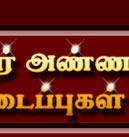Our attention has been drawn to an article published
in the April, June 1959 number of the Bombay quarterly,
the “Quest”, in which a non-Dravidian has indulged in
mischievous propaganda against the literary and cultural
awakening in the South. Under the caption “Tamil Writing
Today,” he has allowed his personal dislikes sway, and
sought to mis-represent and preserve the culture of
the South. He says:-
“The pedantic and academic trend in Tamil is more or
less purist, and insists upon the rapid and almost immediate
assimilation and use of the Tamil language for Governmental,
educational and other public purposes. The movement
against the so-called Aryan and other alien influences
in the Tamil language, life and literature is at least
as old as the century, if not older.”
The movement against Aryan domination in society, religion
and language, which is many centuries older, is nothing
but the assertion of cultural self –respect by the Dravidian
people. No wonder, exploiters do not like the exploited
to assert themselves. The writer of the “Quest” article
traces the continuity of this self-respect movement
from the pre-independence era to the post-Independence
period. He says:-
“Since independence, the tendency among the purists
and the Dravidians has been to keep the language traditionally
pure and to overweight it with words not now in use,
and to keep it at a jingoistic and often chauvinistic
level of nostalgia, looking back upon a past which is
by no means definitely proved……”
It is easy to see the motive of the writer of the article
– he is against the purity of the Tamil language, and
wants the corruption of Aryan influence to be kept untouched
and intact. He goes on to say:-
“This harking back to a past, for cultural inspiration
can be salutary within limits, but in large doses is
likely to be harmful, as it is tending to become of
recent years.”
Yes, it is harmful – but harmful to whom? The exploiters,
of course. As for the exploited, the Dravidian cultural
revival is having most beneficial effect on them. The
writer then refers specifically to present-day Dravidian
literature in the same strain. He says:-
“Apart from the purely Dravidian writing, there is a
set of academic writings there is a set of academic
writing that are also Dravidian-inspired, if not self-confessedly
so. The so-called learned world in Tamil, the Universities
and the Colleges, and the Educational Institutions are
full of persons deep in this Dravidian inspiration.”
The writer is right in this understanding of the present
situation, so far as the intellectual world is concerned.
Referring to Tamil Professors and Lecturers, he speaks
slightingly of them, and adds,
“Their vocabulary is almost always shorn of Sanskrit
elements, although it is extremely difficult to think
of Tamil language shorn of the elements of Sanskrit,
even in the remotest antiquity available to us.”
This is not at all correct, for there have been great
Tamilian scholars and savants who disliked the corrupting
influence of Aryanism, and have used pure and chaste
Tamil. Even if one assumes this to be correct, that
only goes to show to what deep-seated extent corruption
has corroded into the very basis and texture of the
Tamil language. The time has come definitely when the
baneful influences of an alien language and culture
should be eschewed from the homeland of the Dravidian
people. Non-Dravidians will of course resist this attempt.
But time and the forces of time are with us. We will
win.
(Editorial - 19-07-1959)





